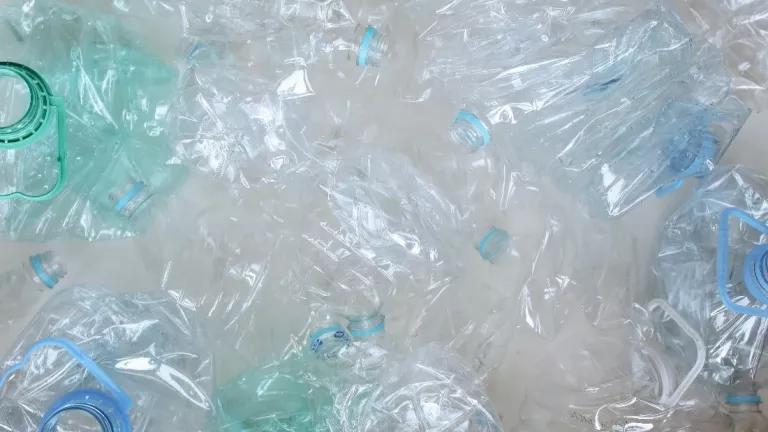PFAS: No Forever Exemptions for Forever Chemicals
The goal is safer and better solutions, so any exemptions from laws and regulations restricting PFAS must be temporary.

PFAS have contaminated our air, water, food, homes and bodies - and have even been found at health-concerning levels in rainwater around the globe. It's time to stop all unnecessary uses of PFAS to protect our health and environment.
Oleksandr P. via Pexels
Legislatures across the country are revving up to continue the fight against PFAS pollution in a collective moment that calls for both ambitious action and caution in protecting against special interest carve outs that risk harming people and ecosystems.
As the harms posed by toxic “forever” PFAS chemicals become increasingly clear, policymakers have begun taking significant steps to curtail their use: many states across the country have already banned the use of PFAS, as a class, in various products including fire-fighting foam, food packaging, textiles, and cosmetics as a first step in turning off the tap on PFAS production. More recently, policymakers in Maine and Minnesota have enacted more ambitious laws that phase out all unnecessary uses of PFAS by 2030 and 2032, respectively, with time-limited exceptions for currently unavoidable uses of PFAS. The European Union, similarly, has proposed to phase out all PFAS uses, with 5 or 12 year derogations (extensions) provided for uses that need more time to develop and transition to safer alternatives. This year, states are set to continue leading the way to protect people from PFAS, with 18 states having introduced PFAS-related bills so far this year.
Every time a piece of PFAS legislation is written or a regulation is developed, there is a risk that special interests will succeed in watering down its ambition or win carve outs for their products. In particular, we are concerned that stakeholders may call for broad exemptions for PFAS-based refrigerants and other gases related to the phasedown of hydrofluorocarbons (HFCs) - a major initiative to prevent harmful climate warming from HFC gases, which are very potent greenhouse gases that, pound for pound, warm the climate hundreds to thousands of times more than carbon dioxide. Some HFCs and, more importantly, most members of the group of alternatives to HFCs called hydrofluoroolefins (HFOs), that have been considered as being climate-friendlier, fall under the definition of PFAS.
Phasing down HFCs is necessary for climate protection; however, this does not justify blanket exemptions from PFAS regulations for the next generation of alternatives. We should be examining the use of PFAS for climate-protection purposes just as carefully as we do for other uses.
Addressing the PFAS Crisis
PFAS are a large group of manmade chemicals often referred to as toxic “forever” chemicals. PFAS chemicals are similar in many ways; most importantly, they are extremely resistant to break down in the environment. This means that PFAS concentrations in our bodies and in the environment will continue to increase, along with the risk of harm, unless we stop their production and use. To compound the problem, 1) many PFAS are also highly mobile in the environment, making their contamination hard to contain; 2) PFAS accumulate in the environment and some accumulate in our bodies and; 3) exposure to well studied PFAS has been linked to a range of health effects, including cancer, reproductive and developmental harm, and immune system suppression.
Despite these known hazards, there are potentially tens of thousands of individual PFAS and over 200 different uses cataloged so far. Due to their persistence and unchecked widespread use, PFAS are now found in our air, water, food, homes and bodies (~98% of people in the US have PFAS in their blood). Levels of PFAS pollution throughout our environment already exceed safety thresholds (for example, PFAS have been found at health concerning levels in rain water around the globe), putting our health and that of the planet at risk. There is an urgent need to reduce our exposure to PFAS.
Essential-use Approach
Traditional regulatory methods for managing chemical production, use, and disposal have largely failed to protect people and the environment from widespread pollution and exposure to harmful chemicals like PFAS. The essential use approach, the basis of the Maine and Minnesota PFAS phase out laws, is a policy tool for managing chemicals of concern that has been gaining prominence as a way to more efficiently and effectively reduce the use of toxic chemicals to protect public health. It holds that chemicals of concern should not be used in products or processes where they are not critical for health, safety, or the functioning of society. Rather, unnecessary uses should be phased out and time-limited exemptions for specific uses should only be permitted if all of the following are true:
- there are no safer alternatives to the chemical available; and
- the function of the chemical is necessary for the product to work; and
- the use of the chemical in the product is critical for health, safety, or the function of society.
The goal of this approach is not to ban products, but to discontinue the use of toxic chemicals when not needed.
To maximize the utility of the essential-use approach, it should be combined with the management of PFAS as a class, rather than one chemical at a time. Studying and regulating PFAS one at a time would require an impractical amount of time to provide health protections and would continue to encourage the regrettable substitution of one PFAS for another.
Policymakers take the lead; industry presses for exemptions
In response to efforts to enact PFAS policies, certain industry voices have attempted to dodge regulation - by claiming certain PFAS are safe, by attempting to redefine which chemicals count as PFAS, or by preemptively claiming large sectors of PFAS uses are "essential.”
Blanket exemptions, which forgo or sidestep an essentiality analysis or determination, defeat the purpose of the class-based, essential use approach and will unnecessarily prolong the PFAS crisis.
Unsupported claims of safety
History offers us a lesson on claims of PFAS safety. When PFOA and PFOS came under scrutiny, the chemical industry introduced newer short-chain PFAS, including GenX and PFBS, as purportedly “safer” alternatives to long-chain PFAS because they are supposedly eliminated more quickly from our bodies. However, evidence now shows that short-chain PFAS are associated with adverse health effects similar to those of the legacy PFAS they are replacing (PFPrA, PFBA, PFBS, GenX). Importantly, short-chain PFAS are still highly persistent and are even more mobile in the environment than long-chain PFAS. This means their use will result in our continual and increased exposure. Chronic exposure to less bioaccumulative chemicals can still cause harm. As even smaller PFAS (sometimes referred to as “ultra-short chain” PFAS) are being produced and discovered in our environment, we are in danger of repeating this cycle. Excluding certain PFAS from regulation based on unsupported claims of safety will continue to result in these regrettable substitutions.
PFAS are PFAS
Some PFAS producers and users recently offered alternative definitions for PFAS that would exclude products they are looking to protect from policies taking action on the entire PFAS class (see here and here). These alternative definitions are in conflict with the scientific consensus definition developed by the Organization for Economic Cooperation and Development (OECD), which defines PFAS by the presence of the chemical group that imparts persistence (a perfluorinated methylene or methyl group - basically a fully fluorinated carbon atom). Twenty two states have also adopted a very similar definition into law. While the scope of a regulation can be adjusted based on policy considerations–such as a finding that a use is currently unavoidable because it is needed for health, safety, or functioning of society– the definition of PFAS must remain based in science.
Broad sectors of use should not be exempted from review
Another argument used to justify blanket exemptions is the importance of a PFAS subgroup or category of use to achieving climate and sustainability (or other) goals. This form of greenwashing is being used to justify continued PFAS pollution and harm. It is a patently false dichotomy to pit environmental health and climate sustainability as opposing goals. This messaging also cynically assumes the necessity of using toxic chemicals to address climate change and ignores the availability of or the ability to develop safer alternatives. This “critical chemistries” narrative has already been defeated in some sectors that relied on PFAS. For example, PFAS provided a critical surfactant function in aqueous film forming foams (AFFF) for firefighting. Time and again, people were told that PFAS in AFFF were safe and that firefighting foams could not be made without PFAS. Yet, when pushed, industry was able to deliver safer surfactant alternatives. There are now many PFAS-free foams available and in use, including some that are GreenScreen certified.
Defining a use as essential without appropriate review removes any incentives for manufacturers to switch to or develop safer alternatives. Blanket exemptions also wrongly assume that all uses within a product category are the same (in terms of function, availability of alternatives, etc.). The case of F-gases, which are used as refrigerants, foam blowing agents, and in other applications is a helpful one to consider here.
Exemption requests related to the global phasedown of HFCs
HFCs are being phased down across the world under the Montreal Protocol because they are potent contributors to climate change - pound for pound, HFCs warm the climate hundreds to thousands of times as much as carbon dioxide. HFCs are specialty gases used as refrigerants to help create the cooling and heating effect in air conditioners and heat pumps and in refrigeration systems. HFCs are also used in insulating foams for appliances and buildings and in other niche applications.
As we replace HFCs with alternatives that are friendlier for the climate, it should always be our first choice to choose HFC alternatives that have the lowest impact possible on human health and the environment. That has long been part of the tradition of the Montreal Protocol - for example, some 75-85% of products containing the original, ozone-killing chlorofluorocarbons (CFCs) transitioned not to other fluorinated gases but rather to other, less harmful “not in kind” (i.e., nonfluorinated or entirely of another type) alternatives.
Yet, certain chemical producers and users have sought to preserve industry’s unfettered ability to use HFOs without scrutiny. These attempts have included opposing any class-based approach to PFAS management and seeking blanket exemptions from PFAS regulations for sectors transitioning away from HFCs (see here, here, here, and here).
But many of today’s large HFC-using sectors can already transition to non-PFAS alternatives. For example, when building new supermarkets there are a wide range of environmentally preferable alternatives such as pure hydrocarbons and carbon dioxide that can be used. As refrigerants, pure hydrocarbons and carbon dioxide are as environmentally benign as it gets (the hydrocarbons are not combusted, and the quantities of carbon dioxide are negligible compared with fuel combustion). They do introduce other challenges, however, such as managing the flammability and high operating pressures of the gases. These engineering challenges are increasingly being solved, and applications of these safer alternatives continue to grow. On the other hand, PFAS pollution is incredibly difficult to contain and clean up; therefore continued use of PFAS-based refrigerants will further exacerbate the already high levels of PFAS being detected in homes and people.
HFC and refrigerant end-uses are wide and varied and non-PFAS alternatives are not currently market-ready for all those uses. An essential use framework provides the flexibility required to carve out time for the development of safer alternatives where needed. By granting blanket exemptions in PFAS policies for these types of sectors, we would do ourselves a great disservice by short circuiting the impetus for innovation and improvement.
Conclusion
To realize the full potential of the essential use approach to protect public health and the environment:
- The scientific definition of PFAS must be maintained and PFAS managed as a class
- Blanket exemptions and carve outs for entire sectors from essential-use analyses must be avoided
- Industry should incorporate the risks posed by PFAS to human health and the environment into their decision making and transition away from PFAS as quickly as possible







